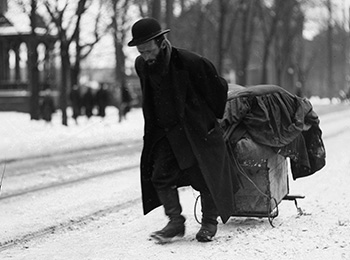Jews in Toronto began leaving the Spadina–Kensington Market neighbourhood as early as 1930, but it was only a trickle. After World War II, that trickle became a mass migration, as is recounted in this edited excerpt from Toronto: Biography of a City.
One reason that Jews opted for Forest Hill was that they had been “discouraged” by land covenants from purchasing homes in affluent Lawrence Park, a post-Second World War suburban development east of Yonge, north of Eglinton, and west of Bayview.
The Jewish population of Forest Hill and the adjacent York Township, centred on and around Bathurst Street, soon exceeded 18,000 and by 1961, 42,000. In 1951, 40 per cent of the population in the village was Jewish, the “highest proportion in any Canadian municipality.” It took somewhat longer for synagogues and Jewish community institutions to follow. In 1954, for example, of the 48 synagogues in Toronto, only five were located north of St. Clair Avenue.
In contrast, of the 90 or so synagogues in the GTA today, fewer than 10 remain south of Dupont Avenue. In any event, contractors could not build houses fast enough, and Bathurst, which up to then had been akin to a rural road in North York was transformed into a major artery with the attendant problems (it wasn’t until a tragic accident took the life of two young girls that proper sidewalks were built).
Erna Paris’s nouveau riche parents (as she describes them) migrated to Forest Hill from their home in the Annex, as so many other Jewish families did, when Erna was a young girl, long before she became a successful journalist and writer. Forest Hill, she recalled, was a world unto itself.
“Our lives in the ‘40s and ‘50s were insular and ‘unreal’ – unconnected to the WASP reality of Toronto, unconnected to the rural reality of Canada,” she wrote in a 1972 memoir. “We knew almost nothing beyond the Village, the downtown department stores where we’d sometimes wander on Saturday afternoon and charge clothes to our fathers’ accounts, and the bits of northern Ontario where we summered and wondered at the people who stayed there after Labour Day.” The “spoiled Forest Hill snobs,” as they were derisively known far and wide, found a real sense of security in the Bathurst and Eglinton ghetto, which merely reinforced Jewish exclusivity and led to even more Jews finding their way there. To Toronto Jews, Bathurst Street had become “sacred space,” or in the words of one Jewish resident in 1995, “what the Nile is to Egypt: a narrow strip of life with desert on both sides.”
Who could fault that self-segregation? In the '40s and '50s, despite the revelations of the Holocaust, anti-Semitic discrimination and racism were alive and well in Toronto. In 1946, a Gallup poll showed that for a majority of Canadians, the two least-desirable immigrant groups were the Japanese, followed by the Jews. Though Canadian regulations made it difficult to immigrate to the country, with some ingenuity and help from local communities, Jewish Holocaust survivors started rebuilding their broken lives in Toronto (and other Canadian cities).
Toronto was a lot better than where they came from but was certainly no multicultural, tolerant haven. The Toronto General Hospital did not hire Jewish staff and allowed only one Jewish intern a year. And though the University of Toronto faculty of medicine did not have a quota system against Jews and other minorities, its admission committee was concerned about the number of Jewish applicants. Likewise, businesses and resorts either banned Jews outright or creatively invented ways to deny them job opportunities, as Pierre Berton discovered while he was researching his bold and eye-opening article “No Jews Need Apply,” published in Maclean’s on Nov. 1, 1948. Much to his dismay, he learned that the magazine’s parent company, Maclean Hunter, did not hire Jews either. “It’s company policy,” he was matter-of-factly informed.
The reaction to the Jewish presence was muted in Forest Hill, but that subtlety could not entirely mask the aversion many old-stock Torontonians felt about this perceived invasion. Despite efforts by non-Orthodox Jews to shed their shtetl or old-country Yiddish mentality and embrace “Canadian” values, they still remained outsiders in the eyes of the wealthy Protestant populace.
As John Seeley and his team documented in the 1956 sociological study Crestwood Heights (about Forest Hill), Christian parents did not want their children associating with Jewish children – inherent Jewish insecurity, one Christian woman said, made Jews too “materialistic” and showy – and if they could afford to do so sent them to private schools where it was far less likely they would encounter Jews. A byproduct of this was that Forest Hill Collegiate became overwhelmingly Jewish, much as many schools in Thornhill are today.
Excerpted from Toronto: Biography of a City, by Allan Levine, © 2014. Published by Douglas & McIntyre. Reprinted with permission of the publisher.
